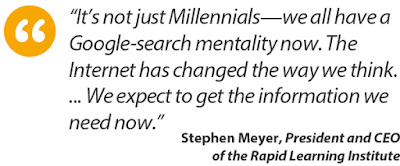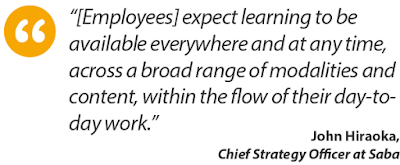Back in 2017, the Association for Talent Development (ATD) conducted a survey on microlearning. According to their research results, 92% of organizations are already using microlearning and planned to do more of it. More than 67% of organizations not using microlearning planned to start doing so in 2017. Undeniably, microlearning was the focus of the training industry last year.

A screenshot from Google Trends
This year, that focus isn’t expected to shift. Microlearning is predicted to continue leading discussions in 2018. Where can microlearning make the most impact? Here are some of the opportunities I think training and development professionals should watch out for:
Opportunities for Microlearning Impacts
Crisis, urgent, rapid answers needed.
With the dynamic and fast-paced nature of work in an organization’s environment of rapid change (vortex of the workplace), employees must use their time efficiently. When a problem arises, they must be able to solve it quickly. Microlearning tools enable this by providing information when and where the need arises.
As-it-happens need for answer.
Microlearning helps workers obtain solutions to their problems in real time. That is, the right information can be quickly accessed in the workplace when learners need it. And, this is essential because “we all have a Google-search mentality now,” not just Millennials, says Stephen Meyer, president and CEO of the Rapid Learning Institute. “The internet has changed the way we think. … We expect to get the information we need now.”

Customers teaching themselves and employees gaining new knowledge from experience.
Because microlearning provides the right information at the right time, it allows employees (or customers) to rapidly acquire skills that will help them solve problems themselves. This method of problem-solving sticks in their memory because research has shown that we retain more when we recall information from memory. It obviously builds up valuable experience knowledge.
Constant updates make it easy for microlearning content to adapt to changing needs of workers.
In an age where workers heavily rely on technology to get the job done and where that technology is constantly improved and updated, learning tools and content must keep up. Unlike traditional learning resources, microlearning content can easily be created or revised/updated to help address problems and issues almost as soon as they come up.
In-between formal learning and applications.
Microlearning happens outside a classroom setting. Within just a small amount of time, learners can consume learning content in the form of one-page articles or 10-minute videos or even snippets of information they can quickly access.
Self-driven, continuous learning
“Employees want more than structured corporate training and development programs. They want to discover and define their own personal learning journeys,” says John Hiraoka, chief strategy officer at Saba. “They expect learning to be available everywhere and at any time, across a broad range of modalities and content, within the flow of their day-to-day work.”

Microlearning motivates workers to pursue learning on their own. This self-driven, continuous learning is empowering for workers and translates into operational excellence, improved efficiency and reduced training and development costs.
There are more opportunities for microlearning impacts, such as rapid, no-wait time onboarding; obsolescence of knowledge; spaced-out learning delivery; subscription learning, and many others.
What other opportunities do you predict for microlearning? Share your thoughts in the comments below.
References
ATD Research. Microlearning: Delivering Bite-Sized Knowledge. April 2017
Biz Library/Association for Talent Development. What Trends are Going to Shape Employee Training in 2018?
Annie Murphy Paul. How to Make Microlearning Matter. Society for Human Resource Management, May 1, 2016
Greg Blackburn. Microlearning in Learning and Development: The Digital Industrial Revolution. eLearning Industry, February 16, 2017
Susan Mazza. Develop More Leaders with These Three Microlearning Opportunities. SABA Blog, January 12, 2018
Tip #42 – Provoking Learners with Story Questions
Tip #134 – Microlearning Leads to Rapid Skill Acquisition
Tip #158 – What Happens If There Is a Chip on Your Windshield? Cases of Microlearning Impacts
Tip #164 – Vortex of the Workplace and Microlearning Fix
Ray Jimenez, PhD
Vignettes Learning
“Helping Learners Learn Their Way”

